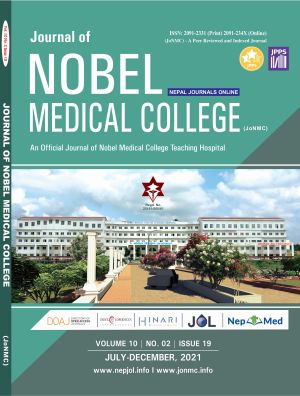Status of Vitamin D among People Visiting a Tertiary Care Center of Eastern Nepal: A Hospital-Based Study
DOI:
https://doi.org/10.3126/jonmc.v10i2.41770Keywords:
Nepal, Tertiary care, Vitamin D DeficiencyAbstract
Background: Vitamin D deficiency is a serious health-problem worldwide and the estimation of its plasma concentration is crucial. The study aims to determine the circulating levels of vitamin D in patients visiting Birat Medical College Teaching Hospital, one of the tertiary care centers of Eastern Nepal.
Materials and Methods: It was descriptive cross-sectional study conducted in the Department of Biochemistry at Birat Medical College Teaching Hospital, Nepal. From the hospital registry, clinical data of 250 patients including their age, gender and serum 25-hydroxy vitamin D was retrieved for the four months of May – August, 2021. The vitamin D status was classified as deficiency (<10 ng/mL), insufficiency (10–30ng/mL), sufficiency ≥ 30ng/mL) and toxicity (≥ 100 ng/mL).
Results: Out of total subjects (n=250), none of them showed toxic serum concentrations of vitamin D, 38% had sufficient, 57% had insufficient and 5% had deficient levels of this vitamin. Among affected individuals, vitamin D insufficiency had predominated in 41% population who were 41-60 years old. Gender-wise comparison of vitamin D status in the insufficiency group showed around 33% males and 67% females having insufficient levels of this vitamin.
Conclusion: With the vitmain D inssufficieny present in more than half of the study population, it becomes paramount to further scrutinize the associated factors apart from the age and gender. To this end, further studies are needed.
Downloads
Downloads
Published
How to Cite
Issue
Section
License

This work is licensed under a Creative Commons Attribution 4.0 International License.
JoNMC applies the Creative Commons Attribution (CC BY) license to works we publish. Under this license, authors retain ownership of the copyright for their content, but they allow anyone to download, reuse, reprint, modify, distribute and/or copy the content as long as the original authors and source are cited.




